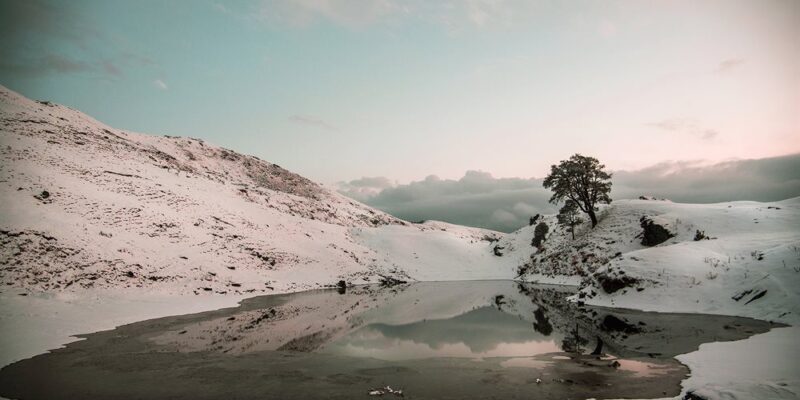
Introducing the Brahmatal Trek
Nestled in the heart of Uttarakhand’s rugged terrain, the Brahmatal Trek has emerged as a sought-after adventure for trekking enthusiasts, particularly those embarking on their Himalayan journeys. This captivating trail weaves through landscapes of unparalleled beauty, offering a harmonious blend of glacial lakes, verdant oak and rhododendron forests, vast meadows, and awe-inspiring vistas of the majestic Nanda Ghunti and Trishul peaks.
For beginners seeking an exhilarating yet accessible introduction to the Himalayas, the Brahmatal Trek presents an ideal opportunity. Its well-defined trails and varying terrains make it a perfect choice for those eager to test their mettle while immersing themselves in nature’s grandeur. In this comprehensive guide, we delve into the trek’s intricacies, equipping you with the knowledge and skills necessary to embark on this unforgettable adventure.
The Bikat Rating Scale: Assessing Trek Difficulty
At the outset, it’s essential to understand the Bikat Rating Scale, a comprehensive system designed to evaluate the difficulty level of treks and expeditions. This scale takes into account the geographical and climatic conditions of each trail, providing trekkers with a reliable gauge for assessing their preparedness.
The Brahmatal Trek is classified as a Level 3 trek on the Bikat Rating Scale, making it an ideal starting point for beginners who are confident in their fitness levels. For those unsure of their abilities, it is recommended to commence with Level 1 or Level 2 treks, which serve as stepping stones to more challenging adventures.
Traversing the Trails of Brahmatal
The Brahmatal Trek commences from the quaint village of Lohajung, perched at an altitude of 2,300 meters. Each day, trekkers will embark on a journey spanning 5 kilometers or more, unveiling a tapestry of diverse landscapes and breathtaking vistas.
Day 1: Lohajung to Gujrani Campsite
The first day’s trek from Lohajung to the Gujrani Campsite sets the tone for the adventure ahead. The initial 3 kilometers offer a gentle introduction, following well-laid-out pathways that lead to the picturesque Begum Top. From this vantage point, the Lohajung Village unfolds below, providing a panoramic view that sets the stage for the journey to come.
Beyond Begum Top, the trail meanders through enchanting oak and rhododendron forests, eventually leading to the Gujrani Campsite at an elevation of 2,750 meters. This relatively easy stretch allows trekkers to acclimatize while savoring the beauty of the surrounding flora.
Day 2: Gujrani Campsite to Brahmatal Campsite
The second day’s trek presents a more challenging endeavor, as the distance to be covered nearly doubles. This is the day when trekkers will be treated to their first glimpse of the Bekaltal Lake, a pristine body of water nestled just 2 kilometers away from the Gujrani Campsite. The path to Bekaltal is easy to moderate, with numerous twists and turns that add to the adventure.
From Bekaltal, the trail ascends steadily, gaining elevation and traversing a sandy terrain that extends for 4 kilometers. At the end of this stretch lies the breathtaking Talindi Top, a beautiful meadow that offers a tantalizing glimpse of the majestic Trishul Peak I.
Continuing onwards, trekkers will reach Jandi Top, a mere kilometer from Talindi Top. This vantage point sets a stunning stage, allowing for unobstructed views of the coveted Trishul 1, 2, and Nanda Ghunti peaks. After Bekaltal, Jandi Top is the last point to replenish water supplies from local dhabas (eateries).
From Jandi Top, the trail descends for 4 kilometers, leading to the Brahmatal Campsite. The serene Brahmatal Lake lies a mere 500 meters from the campsite, beckoning trekkers to take a leisurely stroll and soak in its tranquil beauty during the evening hours.
Day 3: Summit Day
The third day begins with an early start, as trekkers embark on a 3-kilometer ascent to the summit of Brahmatal. The trail maintains a steady and constant incline, challenging trekkers’ endurance while rewarding them with breathtaking vistas along the way.
At the summit, a panoramic spectacle unfolds, with close-up views of the towering Trishul 1, 2, and Nanda Ghunti peaks, as well as glimpses of the Hathi-Goda, Bethartoli, Maiktoli, and Tharkot peaks in the distance. After savoring the summit’s grandeur, trekkers will descend back to the Brahmatal Campsite to rest and rejuvenate.
Day 4: Descent to Lohajung
The final day of the trek involves retracing the path back to Jandi Top, followed by a descent towards Lohajung, covering a distance of approximately 11 kilometers. This constant downhill trek can place significant pressure on the knees, making it essential to employ proper techniques to minimize strain and discomfort.
Fitness Requirements for the Brahmatal Trek
Although the Brahmatal Trek is considered an easy endeavor, it nevertheless demands a certain level of physical preparedness. Trekkers must possess good lung capacity and leg strength to reach the summit safely and return without compromising their enjoyment of the journey.
To ensure optimal preparedness, it is recommended to engage in regular jogging or running sessions, aiming to cover 5 kilometers within 30 to 40 minutes. Incorporating resistance workouts for the legs, such as squats and lunges, as well as core exercises, can further enhance overall fitness and endurance.
For those entirely new to trekking or unsure of their fitness levels, it is advisable to begin with Level 2 treks, such as the Beas Kund or Bhrigu Valley. These lower-altitude and shorter-duration treks serve as excellent introductions, providing insights into the terrain, gear requirements, and fitness levels necessary for more demanding adventures like the Brahmatal Trek.
Essential Gear for the Brahmatal Trek
While Bikat Adventures provides most of the necessary equipment for trekking, such as tents, sleeping bags, crampons, and snow boots, there are some essential items that trekkers must acquire independently to ensure a comfortable and safe journey.
Backpack and Trekking Shoes
A sturdy, lightweight backpack and comfortable trekking shoes are indispensable for the Brahmatal Trek. When selecting a backpack, it is crucial to consider factors such as size, weight distribution, and ventilation to ensure a comfortable and well-balanced carry. Consulting the article “How to Choose Your Backpack” can provide valuable insights into making an informed decision.
Trekking shoes, on the other hand, should be high-ankle and designed specifically for rugged terrain. Unlike regular sports shoes, trekking shoes offer superior support and stability, minimizing the risk of injury.
Trekking Poles
While not mandatory, trekking poles can significantly reduce stress on the legs and knees, particularly during descents and river crossings. They provide added stability and balance, making the journey more comfortable and enjoyable.
Skills to Master for the Brahmatal Trek
Bikat Adventures takes pride in being an adventure learning organization, with a focus on equipping trekkers not only with the ability to complete treks but also with valuable skills in trekking and camping. To achieve this, Bikat has developed learning modules aligned with each level of the Bikat Rating Scale, which are taught in real-time by experienced trek leaders on the trails.
For the Brahmatal Trek, the following skills can prove invaluable:
Ascending and Descending Techniques
Every trail presents unique challenges, and mastering proper ascending and descending techniques can significantly impact the health of your knees and ankles. Maintaining the right rhythm and body position is crucial for navigating ascents and descents with ease and minimizing strain.
Efficient Packing
With daily distances exceeding 5 kilometers on the Brahmatal Trek, efficient packing can make a substantial difference in the comfort of carrying your backpack.
Tent Pitching
Upon reaching your campsite, one of the first tasks will be pitching a tent. Although the trek leaders will guide you through the process, familiarizing yourself with the basics beforehand can be beneficial.
Layering and Hiking Attire
During the winter months, temperatures at the Brahmatal campsite can plummet to -10°C, making proper layering an absolute necessity for protection against the cold. The article “Hiking Attire and Layering” offers insights into the appropriate winter layers and how to layer them effectively while hiking and at campsites.
Using Microspikes
The weather at Brahmatal can be unpredictable, with frequent snowfall during peak winter months. Fresh snow can quickly turn into ice, making the trails slippery and treacherous. Microspikes, which will be provided by Bikat Adventures, can offer the necessary support and balance to navigate these icy conditions safely and efficiently.
Utilizing Gaiters
Around December, the snow level on the Brahmatal Trek can range from 2 to 3 feet. Gaiters are specialized layers worn over shoes and ankles to prevent dirt, pebbles, and snow from entering your footwear. The article “How to Use Gaiters” provides guidance on the proper use of this essential trekking accessory.
Conclusion
The Brahmatal Trek offers an unparalleled opportunity for beginners to immerse themselves in the grandeur of the Himalayas. With its well-defined trails, varying terrains, and breathtaking vistas, this adventure promises an unforgettable journey. By understanding the trek’s difficulty level, preparing adequately, and mastering the necessary skills, you can embark on this remarkable experience with confidence and a deep appreciation for nature’s majesty.
Remember, at Bikat Adventures, our team is always ready to assist you and ensure that your Brahmatal Trek is a resounding success. Feel free to reach out to us with any questions or concerns – we are just a phone call away.











